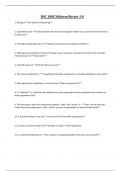BSC 1005 Midterm Review 1-8
1. Biology is **the study of living things**.
2. Superstitions are **irrational beliefs that actions not logically related to a course of events influence
its outcome**.
3. Thinking scientifically relies on **objective observation and experimentation**.
4. Noticing a fuzzy growth on some of the gels in your incubator represents the step of the scientific
method known as **observation**.
5. Scientific data are **all of the above are true**.
6. The correct statement is: **A hypothesis that does not generate a testable prediction is not useful**.
7. After generating a hypothesis, a scientist next **does an experiment**.
8. A **placebo** is a pill that looks identical to a pill containing the active ingredient but contains no
active ingredient itself.
9. The best way to state the relationship between "data" and "results" is: **"Data" are the facts you
collect from your experiment, while "results" are your interpretation of what the data mean**.
10. A scientific theory is one that **is the result of all scientific experiments**.
11. In science, theories tend to be **broader in scope** than hypotheses.
12. In controlled experiments, **one variable is manipulated while others are held constant**.
,13. In a randomized, controlled, double-blind study, **neither the experimenter nor the subject know
whether the subject is in a control group or an experimental group**.
14. If a researcher uses the same experimental set-up as another study but with different subjects, it is
considered **replication**.
15. The best way for a scientist to address his/her own biases is to **use careful controls to minimize
them**.
16. In a line graph, the value of the independent variable is **represented on the x-axis**.
17. The set of analytical and mathematical tools designed to help researchers gain understanding from
the data they gather is called **statistics**.
18. Which of the following statements BEST explains the observation that there are more autism cases
now than in the
past?
a. There are more parents who neglect their children, which is a cause of autism, now than in the past.
b. Autism has been selected for in recent generations by natural selection.
c. The vaccine for measles, mumps, and rubella has been established as a significant cause of autism.
d. Doctors are more aware of the condition and have better techniques for diagnosing and reporting it.
e. All of the above are equally good explanations for the observation that there are more autism cases
now than in the
past. ✔️d. Doctors are more aware of the condition and have better techniques for diagnosing and
reporting it.
19. All of the following are branches of science EXCEPT:
a. physics.
b. geology.
c. logic.
d. astronomy.
,e. zoology. ✔️c. logic.
20. An element:
a. is a substance that cannot be broken down chemically into any other substance.
b. is an atom that has lost either a proton or an electron.
c. must occur naturally on earth somewhere.
d. is a component of an atom.
e. All of the above are true. ✔️a. is a substance that cannot be broken down chemically into any other
substance.
21. __________ is the smallest chemical unit of a type of pure substance.
a. An amino acid
b. A molecule
c. A proton
d. An atom
e. A cell ✔️d. An atom
22. The nucleus of an atom is usually made up of:
a. neutrons, which have no electrical charge.
b. protons, which a positive charge, and neutrons, which have no electrical charge.
c. protons, neutrons, and proteins that hold them together.
d. neutrinos, which have no electrical charge.
e. protons, which have a positive electrical charge, and proteins, which hold them together. ✔️b.
protons, which a positive charge, and neutrons, which have no electrical charge.
23. Which five chemical elements make up 93-97% of the biomass in plants, animals, fungi, and
bacteria?
a. carbon, oxygen, hydrogen, potassium, nitrogen
b. carbon, oxygen, hydrogen, sulfur, potassium
c. carbon, oxygen, hydrogen, sulfur, nitrogen
, d. carbon, oxygen, hydrogen, nitrogen, phosphorous
e. carbon, oxygen, hydrogen, sulfur, phosphorus ✔️d. carbon, oxygen, hydrogen, nitrogen,
phosphorous
24. Of all the elements that occur on earth, how many are found in your body?
a. 4
b. 25
c. 90
d. 10
e. 116 ✔️b. 25
25. The four most abundant elements in living organisms are:
a. carbon, hydrogen, nitrogen, and phosphorus.
b. carbon, nitrogen, oxygen, and calcium.
c. hydrogen, nitrogen, oxygen, and carbon.
d. carbon, nitrogen, potassium, and oxygen.
e. sodium, nitrogen, carbon, and silicon. ✔️c. hydrogen, nitrogen, oxygen, and carbon.
26. There are three principal types of bonds that hold multiple atoms together. These are:
a. covalent bonds, ionic bonds, and disulfide bonds.
b. hydrogen bonds, ionic bonds, and glycosidic linkages.
c. ionic bonds, hydrogen bonds, and ester bonds.
d. phosphate bonds, disulfide bonds, and hydrogen bonds.
e. covalent bonds, ionic bonds, and hydrogen bonds. ✔️e. covalent bonds, ionic bonds, and hydrogen
bonds.
27. Multiple atoms linked together are collectively called a(n):
a. element.
b. molecule.




